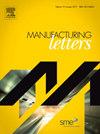DH36 钢和 UNS G10080 钢异种摩擦搅拌焊接接头的冶金特性和机械性能
IF 2
Q3 ENGINEERING, MANUFACTURING
引用次数: 0
摘要
本研究拓展了对异种钢(即高强度造船级 DH36 钢和 UNS G10080 钢)搅拌摩擦焊接工艺的科学理解。实验研究了工具移动速度和切入深度对温度历史、微观结构特征和机械性能的影响。金相特征通过光学显微镜和配备能量色散 X 射线系统的场发射扫描电子显微镜进行了检查。对摩擦搅拌焊接试样进行了显微硬度、冲击和拉伸试验。增加切入深度和降低横移速度导致峰值温度升高,这主要归因于发热量增加。在所使用的工艺参数范围内,工具产生了复杂的材料运动,形成了漩涡状和涡流交错的特征,尤其是在搅拌区/工件界面附近。这些漩涡状特征表现出动态再结晶的细粒微结构。由于动态再结晶的增强,通过增加切入深度和降低横移速度,可减小搅拌区和热机械影响区的晶粒尺寸,从而提高硬度和韧性值。在搅拌区,显微组织显示 DH36 钢中存在针状贝氏体铁素体,而 UNS G10080 钢中存在维德曼铁素体。显微硬度轮廓显示,由于异种钢的显微结构异质性,整个焊接截面的硬度分布不均匀。在横移速度为 40 mm/min、切入深度为 0.2 mm 时,焊接效率达到 106 %,韧性达到 46 J,这归功于充分的发热和晶粒细化。本文章由计算机程序翻译,如有差异,请以英文原文为准。
Metallurgical characteristics and mechanical properties of dissimilar friction stir welded DH36 steel and UNS G10080 steel joints
The present study expanded the scientific comprehension of the friction stir welding process for dissimilar steels, namely high-strength shipbuilding grade DH36 steel and UNS G10080 steel. The effect of tool traverse speed and plunge depth on temperature history, microstructure characteristics, and mechanical properties is investigated experimentally. The metallographic characterizations were examined through an optical microscope and field emission scanning electron microscopy equipped with an energy-dispersive X-ray system. Microhardness, impact, and tensile tests were carried out on the friction-stir-welded specimens. Increasing the plunge depth and reducing the traversal speed resulted in an augmentation of the peak temperature, primarily attributable to higher heat generation. Within the range of process parameters used, the tool produced complex material movement, resulting in swirl-like and vortex-intercalated features, particularly adjacent to the stir zone/workpiece interface. These vortex-like features exhibited dynamically recrystallized fine-grained microstructures. The grain size in the stir zone and the thermo-mechanically affected zone is reduced by increasing the plunge depth and decreasing the traverse speed due to enhanced dynamic recrystallization, subsequently improving the hardness and toughness values. In the stir zone, the microstructure revealed the acicular-shaped bainite ferrite in the DH36 steel and the Widmanstatten ferrite in the UNS G10080 steel. The microhardness contours revealed the uneven hardness distribution across the weld cross-section due to the microstructural heterogeneity in the dissimilar steels. The maximum welding efficiency of 106 % and toughness of 46 J are obtained at 40 mm/min traverse speed with a plunge depth of 0.2 mm, which is attributed to sufficient heat generation and grain refinement.
求助全文
通过发布文献求助,成功后即可免费获取论文全文。
去求助
来源期刊

Manufacturing Letters
Engineering-Industrial and Manufacturing Engineering
CiteScore
4.20
自引率
5.10%
发文量
192
审稿时长
60 days
 求助内容:
求助内容: 应助结果提醒方式:
应助结果提醒方式:


